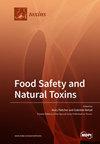关于 El Pañe 水库中蓝藻和蓝藻毒素的新报告:秘鲁安第斯高水源地水质面临的威胁
IF 3.9
3区 医学
Q2 FOOD SCIENCE & TECHNOLOGY
引用次数: 0
摘要
蓝藻是一种世界性生物;然而,气候变化和富营养化正在增加蓝藻藻华(蓝藻花)的发生率,从而提高了饮用、农业和畜牧业水源中蓝藻毒素的风险。本研究旨在确定位于秘鲁阿雷基帕高安第斯地区的 El Pañe 水库中是否存在蓝藻(包括毒性蓝藻)以及蓝藻毒素的发生情况,从而为水质管理提供支持。该研究包括蓝藻形态观察、蓝藻分子测定(16S rRNA 分析)和蓝藻毒素编码基因分析(mcyA 表示微囊藻毒素,cyrJ 表示圆筒孢囊藻毒素,sxtl 表示沙西毒素,AnaC 表示锐毒素)。与此同时,还利用液相色谱-质谱联用技术(LC-MS/MS)进行了化学分析,以检测蓝藻毒素(微囊藻毒素、圆柱孢藻毒素、鲑鱼毒素和锐毒素等)的存在以及微囊藻毒素-LR 的定量。形态学数据显示存在 Dolichospermum sp.通过 16S rRNA 分析还检测到了微囊藻,并在这两种蓝藻中发现了与产生微囊藻毒素有关的 mcyA 基因。此外,还通过化学分析鉴定了微囊藻毒素-LR 和去甲基化的微囊藻毒素-LR。2022 年 5 月和 11 月,微囊藻毒素-LR 的最高浓度分别为 40.60 微克/升和 25.18 微克/升。在蓝藻生物量中检测到了微囊藻毒素。相比之下,在水中(溶解的)未检测到毒素。微囊藻毒素浓度超过秘鲁法规和世界卫生组织(WHO)规定的供人类饮用的水体中微囊藻毒素浓度值(1 µg/L)的许多倍。这份首次综合报告整合了形态、分子和化学数据,证实了 El Pañe 水库中存在两种致毒蓝藻和微囊藻毒素。这项工作表明,有必要对水库中的蓝藻和蓝藻毒素进行持续监测,并采取有效的水管理措施,以保护人类免受这些污染物的危害。本文章由计算机程序翻译,如有差异,请以英文原文为准。
New Report of Cyanobacteria and Cyanotoxins in El Pañe Reservoir: A Threat for Water Quality in High-Andean Sources from PERU
Cyanobacteria are cosmopolitan organisms; nonetheless, climate change and eutrophication are increasing the occurrence of cyanobacteria blooms (cyanoblooms), thereby raising the risk of cyanotoxins in water sources used for drinking, agriculture, and livestock. This study aimed to determine the presence of cyanobacteria, including toxigenic cyanobacteria and the occurrence of cyanotoxins in the El Pañe reservoir located in the high-Andean region, Arequipa, Peru, to support water quality management. The study included morphological observation of cyanobacteria, molecular determination of cyanobacteria (16S rRNA analysis), and analysis of cyanotoxins encoding genes (mcyA for microcystins, cyrJ for cylindrospermopsins, sxtl for saxitoxins, and AnaC for anatoxins). In parallel, chemical analysis using Liquid Chromatography coupled with Mass Spectrometry (LC-MS/MS) was performed to detect the presence of cyanotoxins (microcystins, cylindrospermopsin, saxitoxin, and anatoxin, among others) and quantification of Microcystin-LR. Morphological data show the presence of Dolichospermum sp., which was confirmed by molecular analysis. Microcystis sp. was also detected through 16S rRNA analysis and the presence of mcyA gene related to microcystin production was found in both cyanobacteria. Furthermore, microcystin-LR and demethylated microcystin-LR were identified by chemical analysis. The highest concentrations of microcystin-LR were 40.60 and 25.18 µg/L, in May and November 2022, respectively. Microcystins were detected in cyanobacteria biomass. In contrast, toxins in water (dissolved) were not detected. Microcystin concentrations exceeded many times the values established in Peruvian regulation and the World Health Organization (WHO) in water intended for human consumption (1 µg/L). This first comprehensive report integrates morphological, molecular, and chemical data and confirms the presence of two toxigenic cyanobacteria and the presence of microcystins in El Pañe reservoir. This work points out the need to implement continuous monitoring of cyanobacteria and cyanotoxins in the reservoir and effective water management measures to protect the human population from exposure to these contaminants.
求助全文
通过发布文献求助,成功后即可免费获取论文全文。
去求助
来源期刊

Toxins
TOXICOLOGY-
CiteScore
7.50
自引率
16.70%
发文量
765
审稿时长
16.24 days
期刊介绍:
Toxins (ISSN 2072-6651) is an international, peer-reviewed open access journal which provides an advanced forum for studies related to toxins and toxinology. It publishes reviews, regular research papers and short communications. Our aim is to encourage scientists to publish their experimental and theoretical results in as much detail as possible. There is no restriction on the length of the papers. The full experimental details must be provided so that the results can be reproduced.
 求助内容:
求助内容: 应助结果提醒方式:
应助结果提醒方式:


